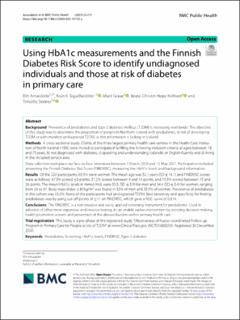| dc.contributor.author | Arnardóttir, Elín | |
| dc.contributor.author | Sigurðardóttir, Árún K. | |
| dc.contributor.author | Graue, Marit | |
| dc.contributor.author | Kolltveit, Beate-Christin Hope | |
| dc.contributor.author | Skinner, Timothy | |
| dc.date.accessioned | 2023-09-08T08:23:12Z | |
| dc.date.available | 2023-09-08T08:23:12Z | |
| dc.date.created | 2023-05-25T11:16:13Z | |
| dc.date.issued | 2023 | |
| dc.identifier.citation | BMC Public Health. 2023, 23 (1), . | en_US |
| dc.identifier.issn | 1471-2458 | |
| dc.identifier.uri | https://hdl.handle.net/11250/3088130 | |
| dc.description.abstract | Background Prevalence of prediabetes and type 2 diabetes mellitus (T2DM) is increasing worldwide. The objective of this study was to determine the proportion of people in Northern Iceland with prediabetes, at risk of developing T2DM or with manifest undiagnosed T2DM, as this information is lacking in Iceland. Methods A cross-sectional study. Clients of the three largest primary health care centres in the Health Care Institution of North Iceland (HSN) were invited to participate if fulfilling the following inclusion criteria: a) aged between 18 and 75 years, b) not diagnosed with diabetes, c) speaking and understanding Icelandic or English fluently and d) living in the included service area. Data collection took place via face-to-face interviews between 1 March 2020 and 15 May 2021. Participation included answering the Finnish Diabetes Risk Score (FINDRISC), measuring the HbA1c levels and background information. Results Of the 220 participants, 65.9% were women. The mean age was 52.1 years (SD ± 14.1) and FINDRISC scores were as follows: 47.3% scored ≤8 points, 37.2% scored between 9 and 14 points, and 15.5% scored between 15 and 26 points. The mean HbA1c levels in mmol/mol, were 35.5 (SD ± 3.9) for men and 34.4 (SD ± 3.4) for women, ranging from 24 to 47. Body mass index ≥30 kg/m2 was found in 32% of men and 35.9% of women. Prevalence of prediabetes in this cohort was 13.2%. None of the participants had undiagnosed T2DM. Best sensitivity and specificity for finding prediabetes was by using cut-off points of ≥11 on FINDRISC, which gave a ROC curve of 0.814. Conclusions The FINDRISC is a non-invasive and easily applied screening instrument for prediabetes. Used in advance of other more expensive and invasive testing, it can enable earlier intervention by assisting decision making, health promotion actions and prevention of the disease burden within primary health care. | en_US |
| dc.language.iso | eng | en_US |
| dc.publisher | BioMed Central | en_US |
| dc.rights | Navngivelse 4.0 Internasjonal | * |
| dc.rights.uri | http://creativecommons.org/licenses/by/4.0/deed.no | * |
| dc.title | Using HbA1c measurements and the Finnish Diabetes Risk Score to identify undiagnosed individuals and those at risk of diabetes in primary care | en_US |
| dc.type | Peer reviewed | en_US |
| dc.type | Journal article | en_US |
| dc.description.version | publishedVersion | en_US |
| dc.rights.holder | © The Author(s) 2023 | en_US |
| dc.source.pagenumber | 10 | en_US |
| dc.source.volume | 23 | en_US |
| dc.source.journal | BMC Public Health | en_US |
| dc.source.issue | 1 | en_US |
| dc.identifier.doi | 10.1186/s12889-023-15122-y | |
| dc.identifier.cristin | 2149188 | |
| dc.source.articlenumber | 211 | en_US |
| cristin.ispublished | true | |
| cristin.fulltext | original | |
| cristin.qualitycode | 1 | |

